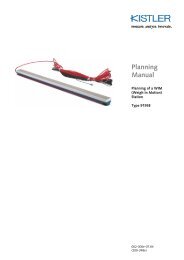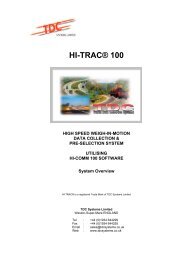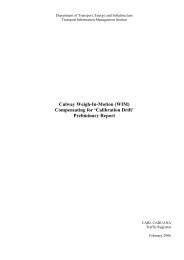Create successful ePaper yourself
Turn your PDF publications into a flip-book with our unique Google optimized e-Paper software.
The shape or the completed pavement over the 240 Metre <strong>Culway</strong> section shall be<br />
judged <strong>to</strong> be acceptable when the maximum deviation from a 5 metre straight edge<br />
placed in any position on the surface does not exceed 4mm.<br />
The pavement over the culvert should be well drained so as <strong>to</strong> maintain constant<br />
strength properties.<br />
5. Surface Treatments<br />
The road surface should be very smooth. A person in a car driven over the site at the<br />
speed limit should not feel any bumps on the road surface.<br />
The preferred surface treatment above <strong>Culway</strong> is 30 mm <strong>of</strong> 10mm dense graded<br />
asphalt. Ideally the road should be sealed with a two coat primer seal as specified in<br />
Main Roads specifications prior <strong>to</strong> a surface treatment <strong>of</strong> 30mm <strong>of</strong> dense grade asphalt<br />
for a minimum distance <strong>of</strong> 120m before and 120m after the culvert.<br />
Typically dense graded asphalt is not used for speeds greater than 80km/hr since the<br />
surface texture <strong>of</strong> dense graded asphalt does not conform <strong>to</strong> MRWA requirements.<br />
However, small lengths <strong>of</strong> dense graded asphalt are only traversed by a vehicle for a<br />
short period <strong>of</strong> time (3-4 seconds) and are unlikely <strong>to</strong> result in the driver losing control <strong>of</strong><br />
their vehicle in inclement weather conditions. Considering that the <strong>Culway</strong> site should<br />
be on a straight section <strong>of</strong> road, the use <strong>of</strong> dense graded asphalt over small section <strong>of</strong><br />
road does not create unsafe driving environment for the mo<strong>to</strong>rists. Therefore it is<br />
recommended that for this purpose that dense graded asphalt be applied.<br />
Under exceptional circumstances it may be permissible <strong>to</strong> apply two lifts <strong>of</strong> either 5mm<br />
or 7mm microsurfacing over a 10mm primer seal in lieu <strong>of</strong> asphalt. In the event that<br />
microsurfacing is not available a Main Roads designed multiple seal treatment may be<br />
applied.<br />
A 10mm dense graded mix should only be placed in layers no greater than 30mm thick.<br />
A 14mm mix would suffice in one layer up <strong>to</strong> 50mm thick. It is recommended that 30mm<br />
<strong>of</strong> a 10mm mix or 40mm <strong>of</strong> a 14mm mix be used for <strong>Culway</strong> sites.<br />
Shorter sections <strong>of</strong> asphalt (i.e.30 Metres) may be permitted if allowed for at road design<br />
stage since altering the road pr<strong>of</strong>ile <strong>to</strong> allow a smooth transition from chip seal <strong>to</strong> asphalt<br />
and vice versa would not pose a problem if done at this juncture.<br />
The lane over the culvert should be clearly marked for the traffic as this encourages the<br />
vehicle <strong>to</strong> track down the centre <strong>of</strong> the lane. Where lane discipline is poor the installation<br />
<strong>of</strong> raised pavement markers may be considered.<br />
6.0 Other <strong>Culway</strong> <strong>Design</strong> Considerations<br />
The preferred <strong>Culway</strong> layout is shown on Drawing 200331-007. (A link will be added <strong>to</strong><br />
this drawing).<br />
6.1 Placement <strong>of</strong> Electrical Equipment<br />
All electrical equipment associated with the <strong>Culway</strong> shall be installed outside the clear<br />
zone as defined in Table 3.1 <strong>of</strong> the AASHTO Roadside <strong>Design</strong> <strong>Guide</strong>. If this is not<br />
practical, consideration should be given <strong>to</strong> providing a safety barrier not only <strong>to</strong> protect<br />
errant vehicles from collision with the equipment but also <strong>to</strong> protect the equipment.<br />
Page 8<br />
Any safety barriers required shall be designed in accordance with the <strong>Guide</strong> <strong>to</strong> Safety<br />
MAIN ROADS Western Australia<br />
<strong>Guide</strong> <strong>to</strong> the <strong>Design</strong> <strong>of</strong> <strong>Culway</strong>.doc
















